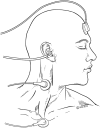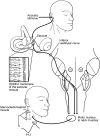Practice guideline: Cervical and ocular vestibular evoked myogenic potential testing: Report of the Guideline Development, Dissemination, and Implementation Subcommittee of the American Academy of Neurology
- PMID: 29093067
- PMCID: PMC5705249
- DOI: 10.1212/WNL.0000000000004690
Practice guideline: Cervical and ocular vestibular evoked myogenic potential testing: Report of the Guideline Development, Dissemination, and Implementation Subcommittee of the American Academy of Neurology
Abstract
Objective: To systematically review the evidence and make recommendations with regard to diagnostic utility of cervical and ocular vestibular evoked myogenic potentials (cVEMP and oVEMP, respectively). Four questions were asked: Does cVEMP accurately identify superior canal dehiscence syndrome (SCDS)? Does oVEMP accurately identify SCDS? For suspected vestibular symptoms, does cVEMP/oVEMP accurately identify vestibular dysfunction related to the saccule/utricle? For vestibular symptoms, does cVEMP/oVEMP accurately and substantively aid diagnosis of any specific vestibular disorder besides SCDS?
Methods: The guideline panel identified and classified relevant published studies (January 1980-December 2016) according to the 2004 American Academy of Neurology process.
Results and recommendations: Level C positive: Clinicians may use cVEMP stimulus threshold values to distinguish SCDS from controls (2 Class III studies) (sensitivity 86%-91%, specificity 90%-96%). Corrected cVEMP amplitude may be used to distinguish SCDS from controls (2 Class III studies) (sensitivity 100%, specificity 93%). Clinicians may use oVEMP amplitude to distinguish SCDS from normal controls (3 Class III studies) (sensitivity 77%-100%, specificity 98%-100%). oVEMP threshold may be used to aid in distinguishing SCDS from controls (3 Class III studies) (sensitivity 70%-100%, specificity 77%-100%). Level U: Evidence is insufficient to determine whether cVEMP and oVEMP can accurately identify vestibular function specifically related to the saccule/utricle, or whether cVEMP or oVEMP is useful in diagnosing vestibular neuritis or Ménière disease. Level C negative: It has not been demonstrated that cVEMP substantively aids in diagnosing benign paroxysmal positional vertigo, or that cVEMP or oVEMP aids in diagnosing/managing vestibular migraine.
© 2017 American Academy of Neurology.
Figures





Similar articles
-
Ocular versus cervical VEMPs in the diagnosis of superior semicircular canal dehiscence syndrome.Otol Neurotol. 2013 Jan;34(1):121-6. doi: 10.1097/MAO.0b013e31827136b0. Otol Neurotol. 2013. PMID: 23183641 Free PMC article.
-
Rapid cVEMP and oVEMP responses elicited by a novel head striker and recording device.Otol Neurotol. 2012 Oct;33(8):1392-400. doi: 10.1097/MAO.0b013e318268d234. Otol Neurotol. 2012. PMID: 22935811
-
The effect of increased intracranial pressure on vestibular evoked myogenic potentials in superior canal dehiscence syndrome.Clin Neurophysiol. 2015 Apr;126(4):780-6. doi: 10.1016/j.clinph.2014.06.049. Epub 2014 Jul 18. Clin Neurophysiol. 2015. PMID: 25103787 Free PMC article.
-
Clinical significance of cervical and ocular vestibular evoked myogenic potentials in benign paroxysmal positional vertigo: a meta-analysis.Eur Arch Otorhinolaryngol. 2019 Dec;276(12):3257-3265. doi: 10.1007/s00405-019-05674-4. Epub 2019 Oct 11. Eur Arch Otorhinolaryngol. 2019. PMID: 31605189 Review.
-
Ocular vestibular evoked myogenic potentials to air conduction (AC oVEMP): useful in clinical practice?Otolaryngol Pol. 2011 Sep-Oct;65(5):333-8. doi: 10.1016/S0030-6657(11)70722-3. Otolaryngol Pol. 2011. PMID: 22078282 Review.
Cited by
-
Diagnosing vestibular hypofunction: an update.J Neurol. 2021 Jan;268(1):377-385. doi: 10.1007/s00415-020-10139-4. Epub 2020 Aug 7. J Neurol. 2021. PMID: 32767115 Free PMC article. Review.
-
Effects of Kampo medicine hangebyakujutsutemmato on persistent postural-perceptual dizziness: A retrospective pilot study.World J Clin Cases. 2022 Jul 16;10(20):6811-6824. doi: 10.12998/wjcc.v10.i20.6811. World J Clin Cases. 2022. PMID: 36051127 Free PMC article.
-
A Single Fast Test for Semicircular Canal Dehiscence-oVEMP n10 to 4000 Hz-Depends on Stimulus Rise Time.Audiol Res. 2022 Aug 24;12(5):457-465. doi: 10.3390/audiolres12050046. Audiol Res. 2022. PMID: 36136853 Free PMC article.
-
Subjective visual vertical imprecision during lateral head tilt in patients with chronic dizziness.Exp Brain Res. 2022 Jan;240(1):199-206. doi: 10.1007/s00221-021-06247-w. Epub 2021 Oct 23. Exp Brain Res. 2022. PMID: 34687330
-
Acute unilateral vestibulopathy/vestibular neuritis: Diagnostic criteria.J Vestib Res. 2022;32(5):389-406. doi: 10.3233/VES-220201. J Vestib Res. 2022. PMID: 35723133 Free PMC article.
References
-
- Colebatch JG, Halmagyi GM. Vestibular evoked potentials in human neck muscles before and after unilateral vestibular differentiation. Neurology 1992;42:1635–1636. - PubMed
-
- Clarke AH. Laboratory testing of the vestibular system. Curr Opin Otolaryngol Head Neck Surg 2010;18:425–430. - PubMed
-
- Magliulo G, Gagliardi S, Appiani MC, Iannella G, Re M. Vestibular neurolabyrinthitis: a follow-up study with cervical and ocular vestibular evoked myogenic potentials and the video head impulse test. Ann Otol Rhinol Laryngol 2014;123:162–173. - PubMed
-
- Murofushi T. Clinical application of vestibular evoked myogenic potentials (VEMP). Auris Nasus Larynx 2016;43:367–376. - PubMed
MeSH terms
LinkOut - more resources
Full Text Sources
Other Literature Sources
